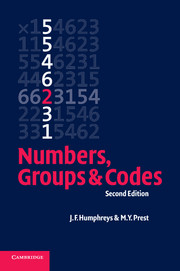Book contents
- Frontmatter
- Contents
- Preface to first edition
- Preface to second edition
- Introduction
- Advice to the reader
- 1 Number theory
- 2 Sets, functions and relations
- 3 Logic and mathematical argument
- 4 Examples of groups
- 5 Group theory and error-correcting codes
- 6 Polynomials
- Appendix on complex numbers
- Answers
- References and further reading
- Biography
- Name index
- Subject index
5 - Group theory and error-correcting codes
Published online by Cambridge University Press: 05 September 2012
- Frontmatter
- Contents
- Preface to first edition
- Preface to second edition
- Introduction
- Advice to the reader
- 1 Number theory
- 2 Sets, functions and relations
- 3 Logic and mathematical argument
- 4 Examples of groups
- 5 Group theory and error-correcting codes
- 6 Polynomials
- Appendix on complex numbers
- Answers
- References and further reading
- Biography
- Name index
- Subject index
Summary
By now we have met many examples of groups. In this chapter, we begin by considering the elementary abstract theory of groups. In the first section we develop the most immediate consequences of the definition of a group and introduce a number of basic concepts, in particular, the notion of a subgroup. Our definitions and proofs are abstract, but are supported by many illustrative examples. The main result in this chapter is Lagrange's Theorem, which is established in Section 5.2. This theorem says that the number of elements in a subgroup of a finite group divides the number of elements in the whole group. The result has many consequences and provides another proof of the theorems of Fermat and Euler which we proved in Chapter 1. In the third section we define what it means for two groups to be isomorphic: to have the same abstract form. Then, after describing a way of building new groups from old, we move on to describe, up to isomorphism, all groups with up to eight elements. The final section of the chapter gives an application of some of the ideas we have developed, to error-detecting and error-correcting codes.
Preliminaries
We introduced the idea of an abstract group in Section 4.3 and then gave many examples of groups. In this section we will prove a number of results which hold true for all these examples.
- Type
- Chapter
- Information
- Numbers, Groups and Codes , pp. 200 - 254Publisher: Cambridge University PressPrint publication year: 2004

